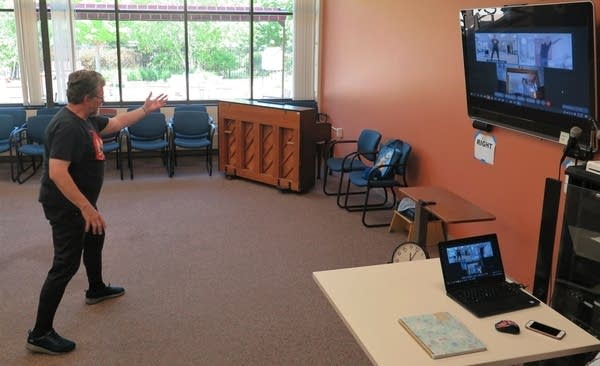Not Zoom weary? Older Minnesotans build on new tech savvy

Go Deeper.
Create an account or log in to save stories.
Like this?
Thanks for liking this story! We have added it to a list of your favorite stories.
David Stewart teaches Tai Chi classes at the Wilder Community Center for Aging in St. Paul. His students — people mostly in their 60s and 70s — learn to gently connect their bodies and minds, and something more.
On this particular Tuesday, he’s dressed to move in a black T-shirt, sweatpants and comfortable shoes.
He looks into the camera and addresses his students virtually, as they’ve done for more than a year during the pandemic.
Stewart, a retired Presbyterian minister, walks his students through the Tai Chi forms, moving from one into another, his eyes mostly closed as he glides across the carpet of the empty room. On the large TV screen, his students move, a half step behind, in their living rooms and bedrooms.
Turn Up Your Support
MPR News helps you turn down the noise and build shared understanding. Turn up your support for this public resource and keep trusted journalism accessible to all.

In a time of social isolation, some of his dedicated students — and some new ones — embraced technology they previously used rarely, if at all.
“It gave us something regular to do,” said Manuel Lopez, 74, of St. Paul. “And frequently we get on a little early or stay a little late and catch up with David and what he and his family were doing.“
Lopez wasn’t all that comfortable with technology at the beginning of the pandemic. But with grandkids in Chicago and St. Paul he learned quickly.
“The pandemic changed things. We started to use delivery of groceries and stuff,” he said, which expanded his idea of just how useful the internet could be.
Lopez is not afraid of technology, but he’s no techie. Now he has learned to be in touch with his siblings and other family throughout the country and world using video conferencing tools.
The Lopezes have a new routine that continues even as things open up: every Saturday they read to their grandkids in Chicago on Zoom.
“I think we'll continue to use it. It gives us some flexibility we wouldn't normally have under these current conditions,” he said.
The couple is part of a trend: Many people used various forms of video chatting through the pandemic to stay in touch with family. Just because they now can see loved ones in person doesn’t mean they’re able to do that all the time. So they’re now connecting in new ways with relatives and friends than ever before.
Louise Hawkley, principal research scientist at the NORC at the University of Chicago, said people who resisted using technology “were in a way forced to consider it.”
“And I think some of them discovered, to their delight, that it wasn't all bad and that there were good things to be had from having video calls with their grandkids, for example,” Hawkley said.
According to AARP, 44 percent of adults 50 and older viewed tech more positively as a way to stay connected than they did before the pandemic. Forty-five percent of those surveyed say they are using video chats now more than before COVID-19. And four out of five said they relied on technology to stay in touch with family and friends.
Hawkley says virtual contact generally is a weak substitute for in-person, face-to-face interaction. But it can be a tool to help fight loneliness and give some sense of community.
The Wilder Center has been able to reach older adults they hadn’t been able to before, but others who took classes in person skip the screen versions.
Moving forward, the Wilder Center plans to start a hybrid model to make classes accessible both in person and on video.
Stewart said it’s been a learning experience for him, too.
“There were a couple times when we were having some problems and I realized that they were chatting with each other, you know, that there were these connections we're emerging, even in this rather strained or unnatural sort of manner,” he said.
He’s watched as this small community has bonded, even over weekly video classes.
“What it says to me is, you know, we're designed, you know, human beings are designed for community. We really do better together,” he said.


